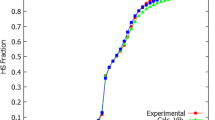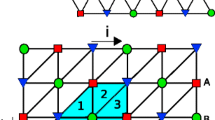Abstract
The model of spin crossover based on the Ising-like Hamiltonian (IHM) has been analysed by deriving the functional of free energy from the mean-field solutions of this Hamiltonian. The contribution of the configurational entropy was found to be identical to that in the functional of the molecular statistical model (MSM) of spin crossover. However, the polynomial expansion over composition (x B) and degree of order (s B) in these functionals differ fundamentally due to different ways of accounting for the effects of molecular interactions. It was found that IHM takes into account next-to-nearest neighbour interactions by introducing affinities of sublattices towards molecules of given kinds. This yields a term proportional to the first power of the degree of order in the functional of IHM, whereas the MSM free energy is only proportional to s 2B . The choice of formal independent variables does not affect the results of simulations of transition curves provided the functional remains unaltered. This provides for more flexibility in numerical simulations of transition curves.
Graphical abstract








Similar content being viewed by others
References
Guetlich P, Goodwin HA (2004) Top Curr Chem 233:1
Blundell SJ (2006) Lect Notes Phys 697:345
Murray KS (2009) Aust J Chem 62:1081
Koudriavtsev AB, Linert W (2010) Zh Strukt Khim 51:364
Wenbin L, Rieter JW, Taylor KML (2009) Angew Chem Int Ed 48:650
Bodenthin Y, Kurth DG, Schwarz G (2008) Chem Unserer Zeit 42:256
Gaspar AB, Munoz MC, Real JA (2006) J Mater Chem 16:2522
Hauser A (2004) Top Curr Chem 233:49
Paulsen H, Trautwein AX (2004) Top Curr Chem 235:197
Wajnflasz J (1970) Phys Status Solid 40:537
Bari R, Sivardiere J (1972) Phys Rev B 5:4466
Zelentsov VV, Lapushkin GL, Sobolev SS, Shipilov VI (1986) Dokl AN SSSR, Ser Khim 289:393
Bousseksou A, Nasser J, Linares J, Boukheddaden K, Varret F (1992) J Phys I France 2:1381
Nishino M, Boukheddaden K, Miyashita S, Varret F (2005) Polyhedron 24:2852
Koudriavtsev AB (1999) Chem Phys 241:109
Koudriavtsev AB, Stassen AF, Haasnoot JG, Grunert M, Weinberger P, Linert W (2003) Phys Chem Chem Phys 5:3666
Koudriavtsev AB, Jameson RF, Linert W (2006) Monatsh Chem 137:1283
Koudriavtsev AB, Linert W (2009) MATCH Commun Math Comput Chem 62:5
Koeppen H, Mueller EW, Koehler CP, Spiering H, Meissner E, Guetlich P (1982) Chem Phys Lett 91:348
Moelwyn-Hughes EA (1970) Physikalische Chemie. Georg Thieme Verlag, Stuttgart
Sorai M (2002) J Chem Thermodyn 34:1207
Chernyshov D, Hostettler M, Törnroos KW, Bürgi HB (2003) Angew Chem Int Ed 42:3825
Kudryavtsev AB, Linert W (1996) Physico-chemical applications of NMR. World Scientific Publishers, Singapore
Acknowledgments
Thanks for financial support are due to the “Austrian Science Foundation” (Project 19335-N17).
Author information
Authors and Affiliations
Corresponding author
Rights and permissions
About this article
Cite this article
Koudrtiavtsev, A.B., Linert, W. Free energy functional of the Ising-like model of spin crossover. Monatsh Chem 141, 601–610 (2010). https://doi.org/10.1007/s00706-010-0315-3
Received:
Accepted:
Published:
Issue Date:
DOI: https://doi.org/10.1007/s00706-010-0315-3




